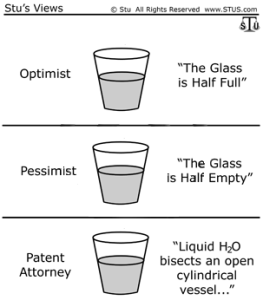 A post from student blogger Nicole
A post from student blogger Nicole
There comes a time in the semester when you start to write claims. When I started to write mine it was weird. That’s the best way I can put it. Weird. The teachers warn you of its sorcery, but you don’t think about it until it’s time to write them. It’s like thinking from a different part of your brain. The part where you look at something as its pieces instead of as a whole. We all view everything as the bigger picture. Let’s take a lanyard, for example. You just see it as something that goes around your neck or is attached to your car keys. But really look at it. Are there designs? Are there different materials? How are the materials attached to each other? What is the structure of it, how do the parts interact with each other? Here is an example of a lanyard connector claim: a coupling portion extending from the distal end of the lanyard connector body to thereby allow selective attachment of an attachment to the lanyard connector. Weird right? Who knew you would ever have to explain something that way. This is the beginning of working out a new muscle. It’s going to be tough at first, but it will get better. I hope. I’m just kidding, I know it will get better. All the teachers are more than willing to help you get through it, but not just get thought it, understand it. Hopefully we will be able to write claims as easily as writing our names.
A good way to start writing a claim would be to write a picture claim. This is describing every part of the invention. You actually write all the details of the invention and all the parts of it working together as a whole. You want to make a list of all the nouns and then describe how they work together. It is important to describe how everything interacts with each other. Yes, again it will be weird, but you get the hang of it. Don’t worry if you’re slow at it because that’s exactly how I am.
Once the picture claim is written you will prune and distill it to become the broad claim. This is getting rid of anything that is unnecessary and making things more general. You want your claims to cover as much as possible so that nobody can find a way around your invention. Nobody wants their patent to be Swiss cheese.
Well I hope you enjoyed my crash course about claims and that I didn’t scare you away! When you finally end up writing claims the first thought will be, “this is weird”. Yes I realize I’ve said weird a bunch of times, probably too many, but it’s the perfect fit.